
If you’re wondering which is a better Chinese smartphone brand then this article Xiaomi vs Oppo vs Vivo will help you understand just that. We’ll cover the key differences between three of the biggest Chinese smartphone companies and help you choose the best, regardless of your budget.
Now, i’ve used hundreds of smartphones over the years and have found Chinese smartphones to be pretty amazing, considering they’re available with similar specs as top rivals and are priced within a reasonable margin.
This article will help you make an informed decision on which brand to go for. I’ll take you through three different segments of smartphones; the flagship, the mid-range and the budget phones and compare key metrics such as battery life, camera capabilities, hardware used and overall performance to figure out which device stands out amongst the three.
Let’s begin!
Before we begin, here’s a brief rundown on what Xiaomi, Oppo and Vivo are in the world of smartphones.
What is Xiaomi?
Xiaomi is a Chinese multinational company that specializes in the manufacture and sale of smartphones and IoT products. They have markets in over 100 countries and the number is still growing. Currently ranked at third best smartphone brand after Apple and Samsung, Xiaomi provides high performance smartphones at a fraction of the price.
What is Oppo?
Right after Xiaomi comes Oppo, which is a prominent Chinese smartphone manufacturer that specializes in smartphones, audio devices and even other electronics. They have a decent market share when it comes to smartphones and have been competing neck to neck with Xiaomi for over 5 years to provide users with better quality devices at lower prices.
What is Vivo?
Here’s the thing, Vivo is not new, it’s actually a sister concern of Oppo and has been functioning for a little over 10 years. They specialize in everything to do with smartphones including accessories, operating systems, software and even online services. Ranking at number 5 just after Oppo, Vivo offers some pretty snazzy smartphones within the same price range as Oppo and Xiaomi.
Xiaomi vs Oppo vs Vivo
Flagships:
Xiaomi 13 Ultra Vs Oppo Find X6 Pro Vs Vivo X90 Pro Plus
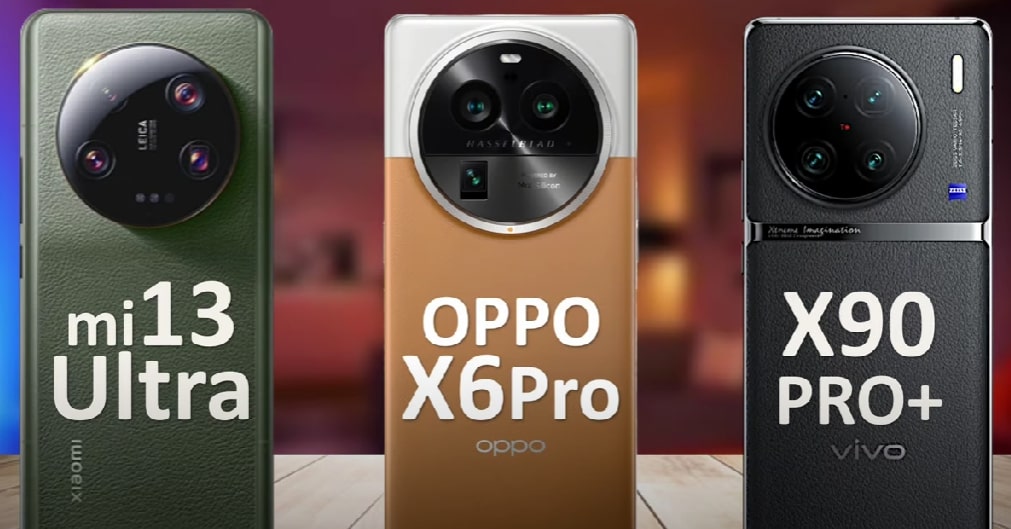
Overview
| Specification | Xiaomi 13 Ultra | Oppo Find X6 Pro | Vivo X90 Pro Plus |
|---|---|---|---|
| Network | 5G | 5G | 5G |
| Launch | March 2023 | November 2022 | November 2022 |
| Dimensions | 163.18 x 74.64 x 9.06 mm | 164.8 x 76.2 x 9.7 mm | 164.4 x 75.3 x 9.7 mm |
| Weight | 227g | 216g | 221g |
| Display | 6.73" AMOLED, 3200x1440, 120Hz | 6.82" AMOLED, 1440x3168, 120Hz | 6.78" AMOLED, 1440x3200, 120Hz |
| Chipset | Snapdragon 8 Gen 2 | Snapdragon 8 Gen 2 | Snapdragon 8 Gen 2 |
| CPU | Octa-core | Octa-core | Octa-core |
| RAM & Storage | 12GB+512GB | Up to 12GB, Up to 256GB | 12GB/16GB, 256GB/512GB |
| Rear Cameras | Triple: 50MP + 50MP + 50MP | Quad: 50MP + 64MP + 50MP + 48MP | Quad: 50.3MP + 64MP + 50MP + 48MP |
| Front Camera | 32MP | 32MP | 32MP |
| Battery | 5000mAh | 5000mAh | 4700mAh |
| Charging | 90W wired, 50W wireless | 65W wired, 50W wireless | 80W wired, 50W wireless |
| OS | MIUI 14 (based on Android 13) | ColorOS 13.1 (based on Android 13) | OriginOS/Funtouch (based on Android 13) |
| Fingerprint Sensor | In-screen | In-screen | Under-display, ultrasonic |
| Price (approx.) | Varies | Varies | About 1030 EUR |
In the realm of smartphones, three powerhouses have emerged with their flagship contenders: Xiaomi 13 Ultra, Oppo Find X6 Pro, and Vivo X90 Pro Plus. These devices exemplify the pinnacle of modern technology, each bringing a unique blend of specifications and features to cater to the discerning user. Let's dive into a comprehensive comparison of these top-tier smartphones.
Design and Display
Starting with design aesthetics, all three phones showcase a dedication to craftsmanship and innovation. The Xiaomi 13 Ultra exudes sophistication with its glass front and back, aluminum frame, and sleek curves. Meanwhile, the Oppo Find X6 Pro catches the eye with its fusion of Gorilla Glass Victus 2 and eco leather, adding a touch of luxury to the device. The Vivo X90 Pro Plus opts for a combination of glass, aluminum, and eco leather, striking a balance between elegance and durability.
When it comes to display technology, each contender brings its own prowess. The Xiaomi 13 Ultra boasts a 6.73-inch WQHD+ AMOLED display with a resolution of 3200x1440 pixels. The Oppo Find X6 Pro offers a spacious 6.82-inch LTPO3 AMOLED display with a resolution of 1440x3168 pixels, while the Vivo X90 Pro Plus matches it with a 6.78-inch AMOLED display at 1440x3200 pixels. Notably, all three devices support a high 120Hz refresh rate, ensuring smooth interactions and immersive visuals.
Performance and Power
Under the hood, these smartphones are powered by the Qualcomm Snapdragon 8 Gen 2 chipset, a testament to cutting-edge processing capabilities. The octa-core CPU configuration, comprising high-performance Cortex-X3 and Cortex-A715/A710 cores, alongside power-efficient Cortex-A510 cores, promises seamless multitasking, efficient power usage, and lightning-fast responsiveness.
Memory and storage configurations offer flexibility to accommodate varying needs. The Xiaomi 13 Ultra offers up to 12GB of RAM and 512GB of internal storage, catering to demanding users. Oppo Find X6 Pro and Vivo X90 Pro Plus users can also enjoy up to 12GB of RAM, with internal storage options of up to 256GB and 512GB respectively.
Photography and Videography
Photography enthusiasts will find themselves spoiled for choice with these flagship contenders. The Xiaomi 13 Ultra boasts a sophisticated triple-camera setup, featuring a 50MP main sensor, a 50MP ultra-wide lens, and another 50MP lens for flexibility and creativity in capturing stunning images. The Oppo Find X6 Pro steps up the game with a quad-camera arrangement, including a 50MP main sensor, a 64MP periscope telephoto lens offering 3.5x optical zoom, a 50MP telephoto lens with 2x optical zoom, and a 48MP ultra-wide lens for expansive shots. The Vivo X90 Pro Plus matches the quad-camera trend with a 50.3MP main sensor, a 64MP periscope telephoto lens with 3.5x optical zoom, a 50MP telephoto lens with 2x optical zoom, and a 48MP ultra-wide lens.
Battery and Charging
Battery longevity and charging efficiency are paramount considerations for modern users. The Xiaomi 13 Ultra houses a sizable 5000mAh battery, while the Oppo Find X6 Pro and Vivo X90 Pro Plus feature equally capable 5000mAh batteries. In the charging department, Xiaomi leads the pack with 90W wired and 50W wireless charging options, promising rapid replenishment. Oppo follows suit with 65W wired and 50W wireless charging capabilities, while Vivo provides 80W wired and 50W wireless charging solutions.
Operating System and Features
Operating systems play a crucial role in user experience, and all three devices run on Android 13-based interfaces. The Xiaomi 13 Ultra sports MIUI 14, the Oppo Find X6 Pro features ColorOS 13.1, and the Vivo X90 Pro Plus offers OriginOS for the Chinese market and Funtouch OS for the global market.
Mid-Range: Xiaomi Mi 11 Lite 5G vs Oppo Find X2 neo vs Vivo iQoo 7 5G
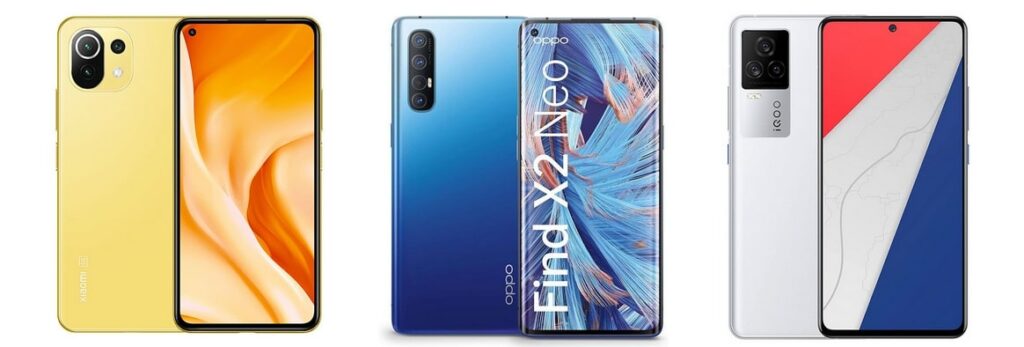
Here are three of the best mid-range smartphones from Xiaomi, Oppo and Vivo that have been crafted to target the younger generation. They all come with different processors, displays, camera setups and more, so let’s check out which one of the three is a better choice for you.
Hardware
The Vivo iQoo 7 is powered by a 2.84GHz Octa Core Snapdragon 888 processor whereas the Oppo Find X2 Neo uses a Snapdragon 865 and the Xiaomi Mi 11 Lite has an older Snapdragon 780G processor.
In terms of storage, the Vivo iQoo 7 offers 8GB and 12GB RAMs along with built-in memory of 128 and 256GB. The Oppo offers the same storage and RAM options, with the exception being one more variant which is 256GB/12GB and the Xiaomi Mi 11 Lite has a total of three variants which include 6GB/128GB, 8GB/128GB, and 8GB/256GB.
The Vivo and Mi come equipped with customizable versions of Android 11 but the Oppo runs on Android 10 which can be upgraded later on to ver 11.
Display
The Oppo Find X2 Neo has a better display among the lot, a 6.7”AMOLED display that delivers 402 pixels per inch and offers a refresh rate of 120Hz along with HDR10+ processing capabilities.
The Vivo iQoo 7 falls in second place with a smaller display at 6.62” and a 1080pi resolution with 120Hz refresh rate and HDR10+.
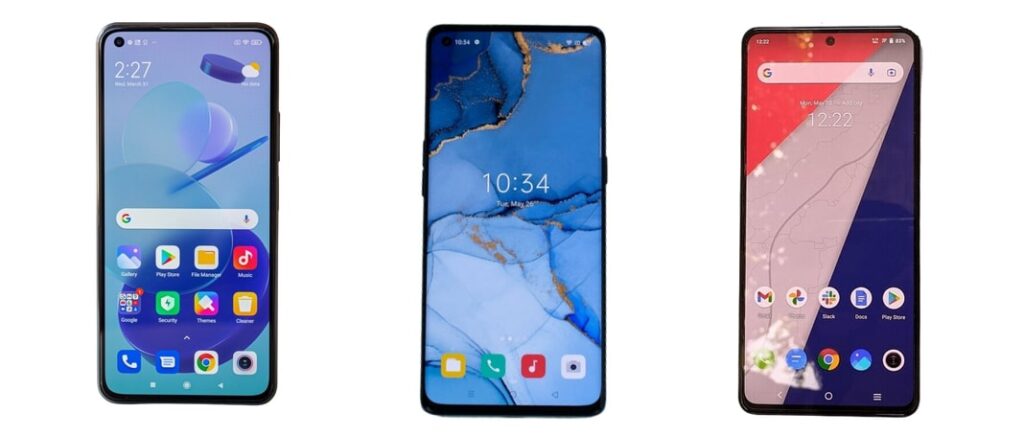
On the other end of the spectrum lies the Xiaomi Mi 11 Lite with the smallest screen of the lot. It uses a 6.55” AMOLED screen that delivers HD resolution at 90Hz refresh rate. It’s not the best display out there for that budget and without doubt, the Vivo has the best display among the three.
Camera
Again, you will notice that all three camera setups are different. The iQoo 7 comes with a 48MP quad camera setup that has optical image stabilization and PDAF, the Find X2 Neo has a 48MP triple camera setup with Laser auto focus, optical image stabilization and PDAF sensors whereas the Xiaomi Mi 11 Lite has a larger 64MP triple camera setup with only PDAF and does not include OIS or laser auto focus.

The Xiaomi and Vivo take better quality videos thanks to their 4K capabilities and gyro-EIS but the Oppo caps out at 2K with HDR.
In terms of the front facing camera, the Oppo, Vivo and Xiaomi have a single lens of 32MP, 16MP and 20MP respectively. All three devices are great depending on the type of photos and videos you want to take. We found that the mid-range device with the better camera setup is the Vivo iQoo 7, hands down.
Battery
The largest and most powerful battery in this segment belongs to the Xiaomi Mi 11 Lite with their 4250mAh Li-Po battery that is capable of 33W fast charging.
The second in line is the Find X2 Neo with a 4200mAh battery and an impressive 65W fast charging capabilities and the one with the smallest battery is the iQoo 7 with a 4000mAh rechargeable battery.
However, among the three, the Vivo iQoo 7 is the only device to provide 120W fast charging capabilities allowing the device to go from 0% to 100% in under 15 minutes.
Overview
| Xiaomi Mi 11 Lite | Oppo Find X2 Pro | Vivo iQoo 7 | |
| Processor | Qualcomm Snapdragon 780G | Qualcomm Snapdragon 865 | Qualcomm Snapdragon 888 |
| Display | 6.55” AMOLED | 6.7” AMOLED | 6.62” AMOLED |
| Camera | 64MP Triple + 20MP Singe | 48MP Triple + 32MP Single | 48MP Quad + 16MP Single |
| Storage | 6GB/8GB RAM;128GB/256GB | 8GB/12GB RAM;128GB/256GB | 8GB/12GB RAM;128GB/256GB |
| Battery | 4250mAh;Quick Charge at 33W | 4200mAh;Quick Charge at 65W | 4000mAh;Quick Charge at 120W |
Overall Verdict - The best all round mid-range device is the Vivo iQoo 7 5G because it comes with a newer processor, a powerful battery, large display and an overall better camera set up than both the Oppo find X2 Neo and the Xiaomi Mi 11 Lite.
Budget-Friendly: Xiaomi Redmi Note 10 vs Oppo A54 5G vs Vivo Y20s
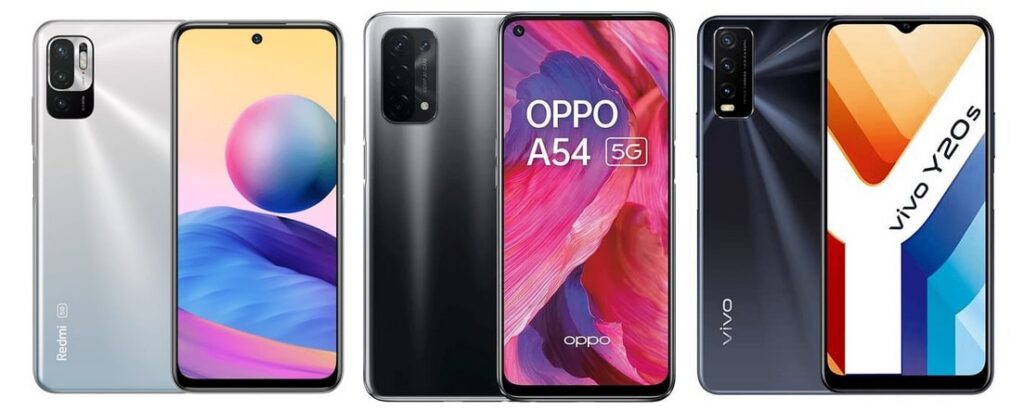
Finally, we’re down to the budget friendly section. These devices are priced under $250 and offer better specs than competitors whose devices fall within the same category. Let’s break them down to determine which is the best budget friendly smartphone among Oppo, Vivo and Xiaomi.
Hardware
All three budget devices run on Octa core processors with different chipsets. The Vivo Y20s comes with a MediaTek Helio G80 chip, the Oppo A54 5G uses the Snapdragon 480 whereas the Xiaomi Redmi Note 10 is powered by the MediaTek Dimensity 700 chipset.
In terms of storage space and RAM, Xiaomi tops the charts with a base of 4GB RAM, a mid segment 6GB and a top tier 8GB RAM along with 64GB,125GB and 256GB storage variants. Second in line is the Vivo Y20s that is 6GB/128GB and the last spot goes to the Oppo A54 with 4GB RAM and 64GB internal storage.
The storage space on all three devices can be expanded with a microSDXC card. It’s also good to know that the Note10, A54 and the Y20s all come with multiple built-in sensors like proximity, compass, accelerometer and even in-display fingerprint sensors.
Display
All three displays are similar in terms of size, screen to body ratio and deliver 16M colors. The one thing that’s different is with the Vivo Y20s because it uses a display that does not process 1080, but it is restricted to 720, so you’re going to experience a drop in the overall display quality.
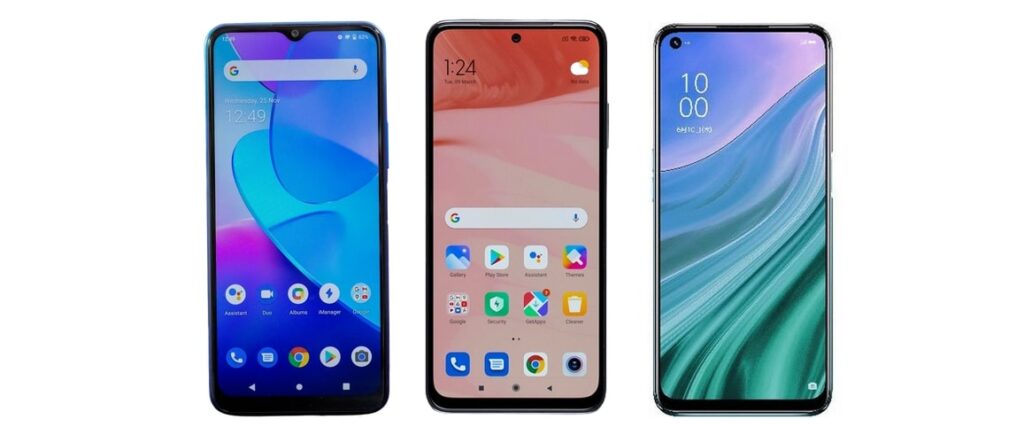
The Oppo A54 and Note 10 have a refresh rate of 90Hz with the A54 being slightly brighter than the Note 10 by 80nits. Based on our experience, the Xiaomi Note 10 and Oppo A54 are on par in terms of quality and size of the display whereas the Vivo is not as great and won’t do well in low lit environments.
Camera
When taking the performance of the camera into consideration, we loved that the Note 10 and Oppo A54 deliver crisp, clear and blur free images via their 48MP lenses. However, the Y20s was not as great since it used an extremely small 13MP lens which is not great in this day and age.
Looking at video quality, all three devices record at 1080p at 30 frames per second which is the base quality you can ask for these days. With the help of the LED flash, all three devices can shoot night videos and pictures but I wouldn’t advise you to get your hopes up as they don’t do a good enough job of capturing night shots well.

The selfie cameras are again not as good as we hoped. The Xiaomi and Vivo come with 8MP single lens cameras while the Oppo A54 gets a 16MP single lens. All three can shoot videos at 1080p and the only difference here is that the Xiaomi and Oppo can shoot panorama whereas the Vivo can not.
Battery
All three batteries are 5000mAh and support fast charging. The only difference in terms of their battery life and performance is that the Vivo and Xiaomi offer 18W wired fast charging whereas the Oppo only lets you fast charge at 10W.
Overview
| Xiaomi Redmi Note 10 | Oppo A54 5G | Vivo Y20s | |
| Processor | MediaTek Dimensnity 700 5G | Qualcomm Snapdragon 480 5G | MediaTek Helio G80 |
| Display | 6.5” IPS LCD | 6.5” IPS LCD | 6.51” IPS LCD |
| Camera | 48MP Triple + 8MP Single | 48MP Quad + 16MP Single | 13MP Triple + 8MP Single |
| Storage | 4GB/6GB/8GB RAM;64GB/128GB/256GB | 4GB RAM;64GB | 6GB RAM;128GB |
| Battery | 5000mAh;Fast Charging 18W | 5000mAh;Charging 10W | 5000mAh;Fast Charging 18W |
Overall Verdict - The best device from this category is actually a tie between the A54 and the Note 10. They’re both powerful devices with better processors, cameras and are built to last. The Y20s does not offer the same level of performance and is much slower.
Takeaway
To summarize from the article Xiaomi vs Oppo vs Vivo, it’s evident that all these devices are different from each other regardless of which category you look at. Xiaomi has a bunch of upgraded tech built-into their devices but it still lacks a few features that Oppo has happily included in their products.
If you’re looking for a high-end smartphone, go for either the Find X3 Pro or the X70 Pro+. For those who prefer mid-range smartphones, you can choose the Vivo iQoo 7 since it has all you would need in that price range and if you’re on a tight budget, then make sure you check out the Oppo A54 or the Xiaomi Note 10.
I’ve given you the breakdown of the main differences between the flagship, mid-range and budget devices from Xiaomi Oppo and Vivo. Now it’s up to you to make your final decision based on what budget you have and the kind of performance you are looking for.
FAQ’s
Is Oppo better or Vivo better?
If you are on a budget and want a smartphone that has a really good camera then go for the Oppo range of smartphones. However if you want a device with more RAM and storage then pick up a Vivo smartphone.
Which is better: Xiaomi, Oppo or Vivo?
Based on our research, Xiaomi devices top the charts when it comes to processing speeds and display quality, Oppo for its camera and Vivo for their storage options. Each one is unique and you will need to know what you’re going to use the device for before choosing the best one.
Why is Xiaomi not good?
Xiaomi devices are known for their low battery performance and backup. Either the device will die out too soon or the battery will begin to wear out after using the device for a couple of months.





